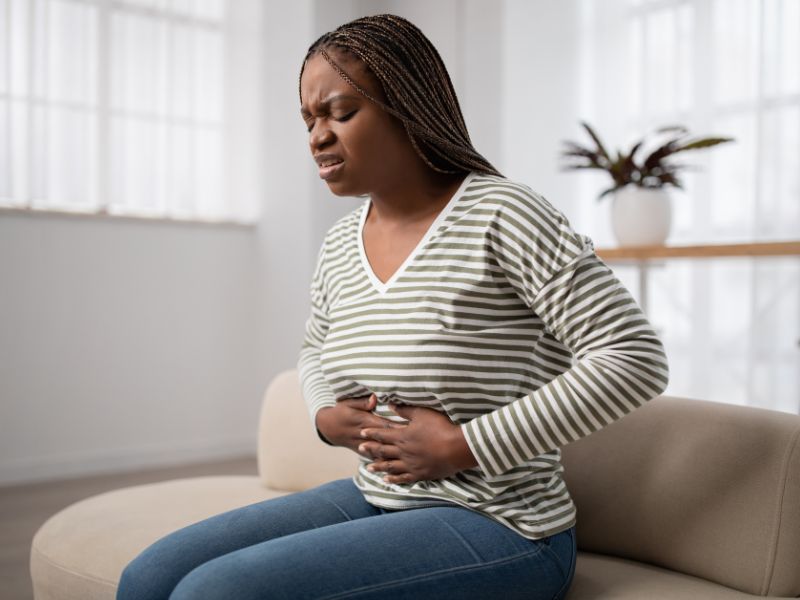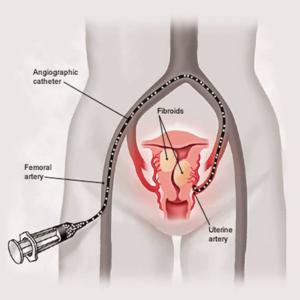
Uterine fibroids are benign tumors that often develop in the uterus. They vary in size and can be present as single or multiple tumors, potentially harming surrounding organs and fertility.
While most women experience uterine fibroid symptoms like heavy bleeding, frequent urination, and bloating, there are specific pain locations that can be associated with fibroids. Depending on the type and location of the fibroids, pain levels can range from mild to severe.
Let’s explore these common pain points and understand how they can impact your daily life and how you can manage your symptoms and find the right treatment.
What Does Pain from Fibroids Feel Like?
Fibroid pain can vary based on the size and location of the fibroids, ranging from mild and dull to sharp and severe in a specific area. Chronic pelvic pain is often mild, dull, and localized, while acute pain may occur when a fibroid has degenerated.
Fibroids may cause discomfort, such as a heavy feeling in the abdomen or pressure on specific organs, like the bladder or rectum. Sharp pain can also occur depending on how the fibroid presses on nerves, muscles, or organs.
What Kind of Pain Do Fibroids Cause?
Uterine fibroid pain and discomfort can occur in many areas throughout a woman’s body:
- Aching or cramping pain: This can be felt in the lower abdomen or pelvis.
- Sharp pain: This can occur suddenly, often during or after sex.
- Pressure or heaviness: This feeling can be in the lower abdomen or pelvis and may be worse when standing or sitting for long periods.
- Back pain: This can result from the weight of the fibroids pulling on the ligaments that support the uterus.
The type and location of a fibroid can significantly influence the type of pain it causes:
Fibroids and Body Pain: A Breakdown
Here, we will explore the common fibroid pain locations and explain how fibroids can cause pain in each situation.
While we often say our ‘stomach’ hurts, the stomach, or gastric organ, is in the upper left quadrant of the abdomen. The region we commonly refer to as the ‘stomach’ is actually the upper abdomen.
Pelvic Pain and Abdominal Pain
While both pelvic and abdominal pain can be uncomfortable and sometimes even debilitating, they are distinct conditions with different locations and potential causes.
Pelvic Pain
The pelvis is the bony structure located below the abdomen. Pelvic pain is typically felt in the lower abdomen, below the belly button.
Pelvic uterine fibroid pain is caused by the weight of the fibroid itself or the fibroid expanding the uterus as it grows. It can feel like fullness or heaviness, making it difficult to lie down, bend, or exercise.
Abdominal Pain

The abdomen is the area between the chest and the pelvis. Abdominal pain can be felt anywhere in this region.
Abdominal fibroid pain usually presents as cramping, especially during or around the time of menstruation. It also can be a sharp pain during or after sex.
Fibroids can indirectly impact the digestive system. Large fibroids can cause pelvic congestion, putting pressure on the intestines and leading to digestive symptoms like bloating, constipation, or diarrhea. This can distend the uterus, which can cause the abdomen to appear larger than normal.
Menstrual Pain (Dysmenorrhea)
Fibroids that grow within the uterine wall (intramural) or inside the uterine lining (submucosal) can increase menstrual pain. As these fibroids grow, they can impact the uterus and menstruation, making cramping more severe than usual. Heavy or irregular bleeding is also possible.
Rectal Pain and Discomfort
If a fibroid is large enough, it can push down on the rectum. This pressure makes bowel movements difficult, possibly causing constipation. Excessive rectal pressure due to constipation can also result in hemorrhoids, which occur due to swollen veins in the anus.
Pain During Sexual Intercourse
Some women with large fibroids may endure pain during sex. One research study found that women with fibroids were two and a half times more likely to report painful sexual intercourse than women without fibroids.¹
Pain during sex may happen only in certain positions, or it might be constant throughout intercourse. We want women to know that pain during sex is not normal and should be investigated. A pelvic exam or ultrasound can determine whether fibroids or another health condition is causing intercourse to be painful.
Back Pain

Pain in your back is caused by fibroids, especially large ones, pressing against the nerves in the lower back or pushing on the muscles. Small fibroids are less likely to exert enough pressure to cause pain outside the uterus. The severity of pain also depends on the part of the back that is affected. Intramural and submucosal fibroids can both cause pain in the lower back.
Leg Pain
Fibroids can cause leg pain if they press on specific nerves or muscles. This usually happens with larger fibroids and those that grow outside the uterus. Pain in the lower back can radiate down the leg, causing widespread discomfort and leading to conditions such as sciatica nerve pain.
Headache
Some women who experience uterine fibroid pain report getting headaches. This can be due to several factors:
- Anemia: Iron deficiency anemia, a common symptom of fibroids, occurs when the body doesn’t have enough iron to supply the red blood cells, which are necessary for transporting oxygen through the blood.
- Hormonal Fluctuations: Fibroids can upset hormonal balance, which can cause headaches,
- Stress and Fatigue: Headaches can develop from fibroid symptoms such as heavy bleeding and pelvic pain.
Common Types of Fibroids Leading to Specific Pain
The type of fibroids can lead to a specific type of pain:
- Intramural and submucosal fibroids inside the uterus can distort its shape and lead to pelvic pain
- Subserosal fibroids located on the outside of the uterus can press against the bladder, rectum, or spinal nerves, causing back pain, pelvic pain, abdominal pressure, and swelling.
- Pedunculated fibroids are attached to the uterus by a stalk. If they become twisted, they cause sudden and severe discomfort.
Out of all the fibroid types, abdominal pain is most commonly caused by subserosal fibroids. These fibroids grow outside the uterus, possibly impacting other organs as they grow. Sometimes, subserosal fibroids are attached to the uterus by a stalk (pedunculated), potentially leading to acute pain if the stalk is twisted and shuts off the blood supply.
In some cases where a fibroid outgrows its blood supply and degenerates, part or all of the fibroid can calcify and take on the hardness of bone. Although uncommon, calcified fibroids can lead to severe abdominal pain or heavy pressure.
How Uterine Fibroid Embolization (UFE) Manages Fibroid Pain

If you are experiencing abdominal discomfort, back and leg pain, or pain in the uterus and lower back due to fibroids, uterine fibroid embolization (UFE) may be a solution. UFE is a minimally invasive treatment that addresses the root of the fibroid pain by shrinking the fibroids themselves.

“To any women out there, if you are dealing with fibroids and think that surgery is your only option, please look into uterine fibroid embolization and Dr. White at USA Fibroid Centers.” — Cara Maria Sorbello
Unlike fibroid surgery, UFE is performed on an outpatient basis, allowing for a quicker recovery time and less disruption to your daily life. Most women return to normal activities within the first week or two, making UFE an excellent option for fibroid pain relief.
One significant benefit of UFE is that the embolic material used during the procedure continues to shrink fibroids over time. This means that women often only need one treatment to manage their fibroid symptoms, unlike myomectomy, which may require multiple surgeries to remove recurring fibroids. UFE offers a long-term solution for fibroid-related pain and discomfort, improving overall quality of life.
Take the First Step Toward Being Pain-Free
At USA Fibroid Centers, our leading fibroid specialists carefully assess your fibroid symptoms and recommend the best treatment option for you. We offer innovative techniques like UFE, a nonsurgical procedure that can significantly reduce or eliminate pain from fibroids. We use advanced imaging such as an ultrasound or MRI to ensure a precise diagnosis and treatment using guided imagery. At your consultation, our experienced interventional radiologists will make treatment recommendations that will fit your needs and lifestyle to help reduce pain from fibroids.
We have locations throughout the country for your convenience and virtual doctor appointments. Call 855.615.2555 to schedule a consultation at a location near you or make an appointment online today.
FAQs
Is it Normal for Fibroids To Cause Pain?
Fibroids can cause pain as they take up space in the body and put pressure on surrounding tissues. This can cause pain in the back, legs, and pelvis because the nerves, veins, or arteries in the pelvic region can become compressed. This is not necessarily a cause for alarm, but it becomes a more serious condition when severe pelvic pain is coupled with bleeding.
Can Fibroids Cause Discomfort?
Yes, fibroid symptoms can cause discomfort. While not all women have symptoms, many do express feelings of discomfort or pain.
What Kind of Fibroid Pain Do Women Experience?
Women with large fibroids often experience heaviness or pressure in their pelvis or lower abdomen, described as vague discomfort rather than sharp pain. An enlarged uterus can also make lying face down, bending over, or exercising difficult.
How to Talk to Your Doctor About Fibroid Pain?
When discussing fibroid pain with your doctor, be as specific as possible. Describe the location, intensity, and frequency of the pain. Note any triggers or factors that seem to worsen or improve your symptoms. This information will help your doctor accurately diagnose and treat your condition.
When Should I See a Doctor About Fibroid Pain?
Seek immediate attention If you experience:
- Severe abdominal pain that doesn’t respond to medication
- Heavy bleeding with dizziness, fatigue, or weakness
Outside of these extreme situations, fibroid pain is still a problem. Consult a fibroid specialist, such as an interventional radiologist, to assess the severity of your condition and determine the appropriate treatment.
QUESTIONS? TALK TO A FIBROID SPECIALIST
References
- Anne Zimmermann, David Bernuit, Christoph Gerlinger, Matthias Schaefers, and Katharina Geppert, “Prevalence, symptoms, and management of uterine fibroids: An international internet-based survey of 21,746 women,” BMC Women’s Health, https://doi.org/10.1186/1472-6874-12-6



